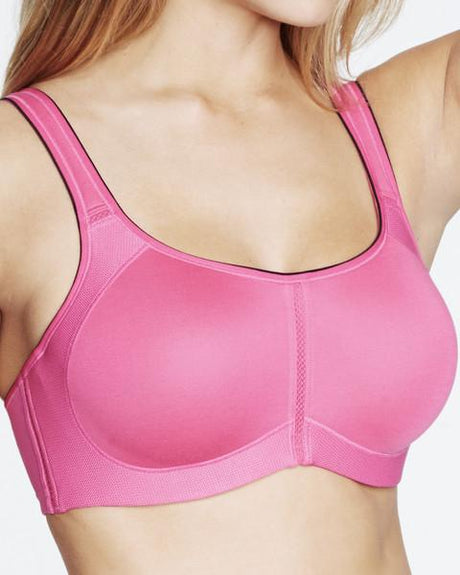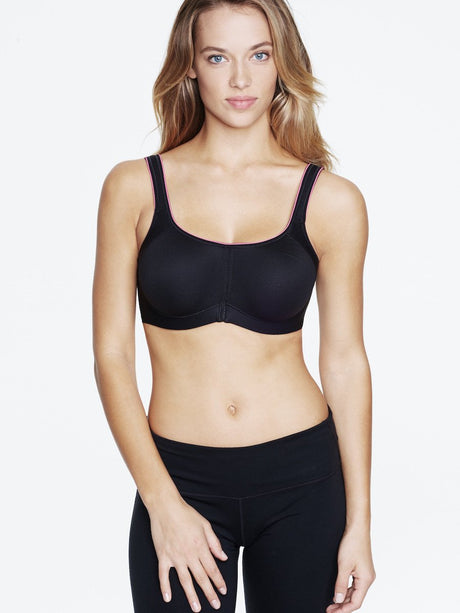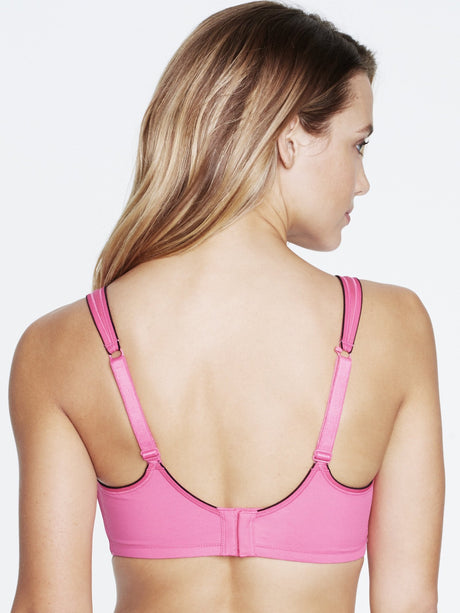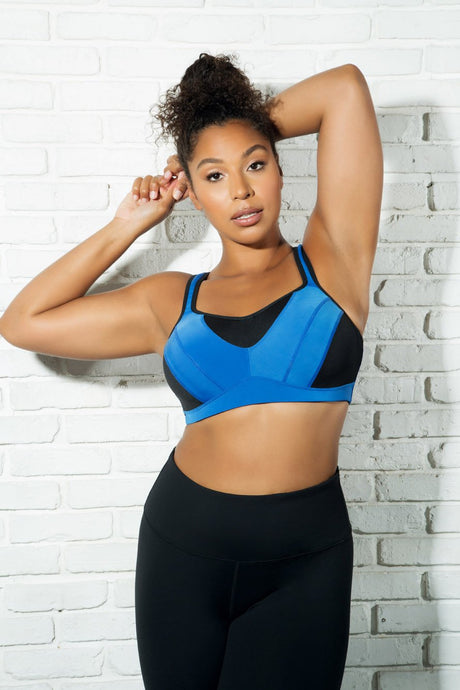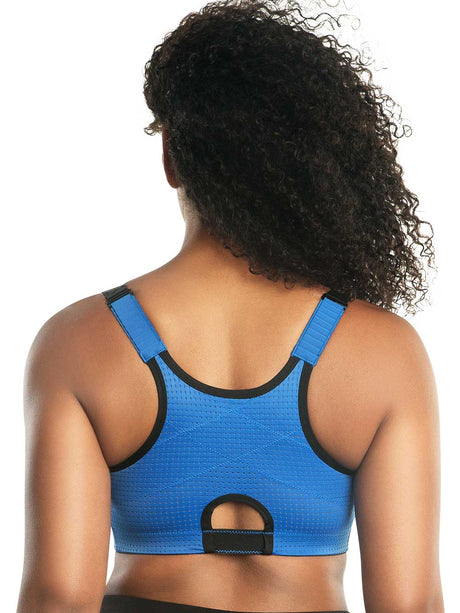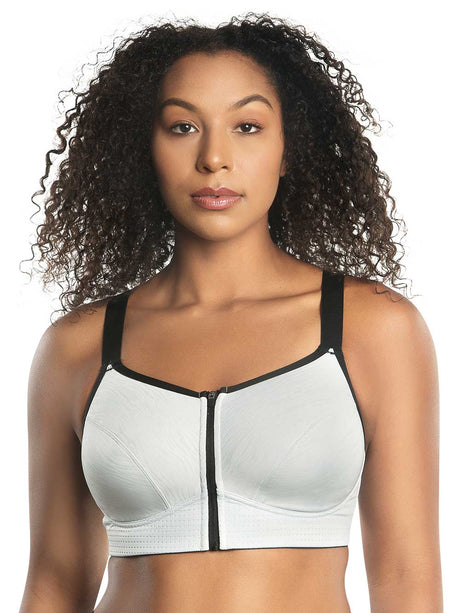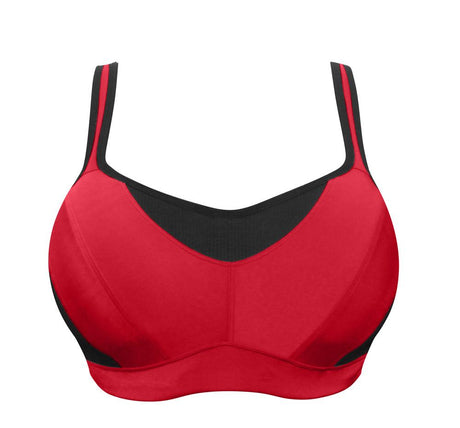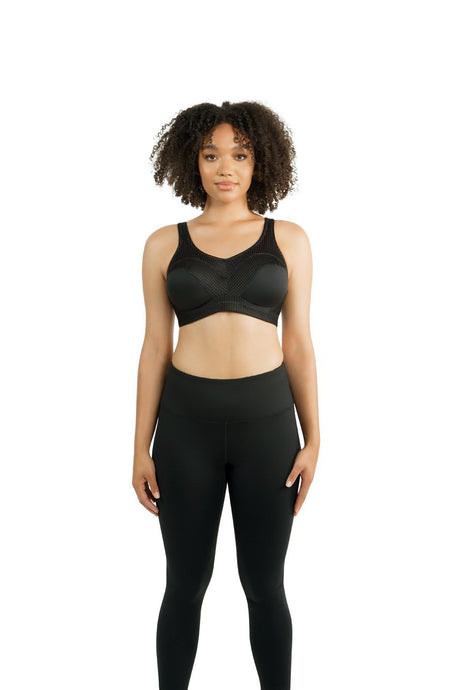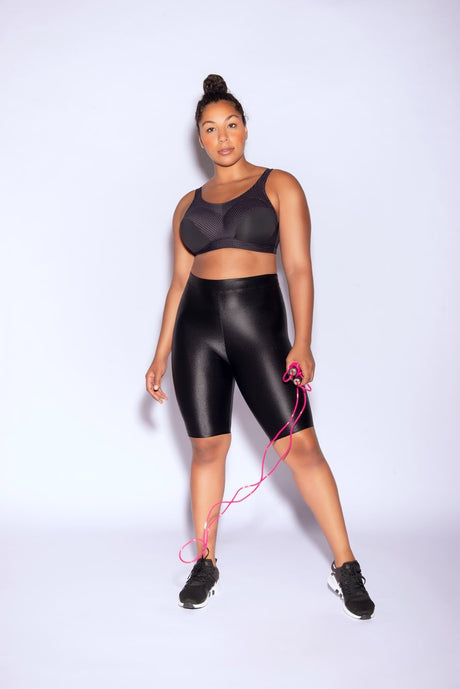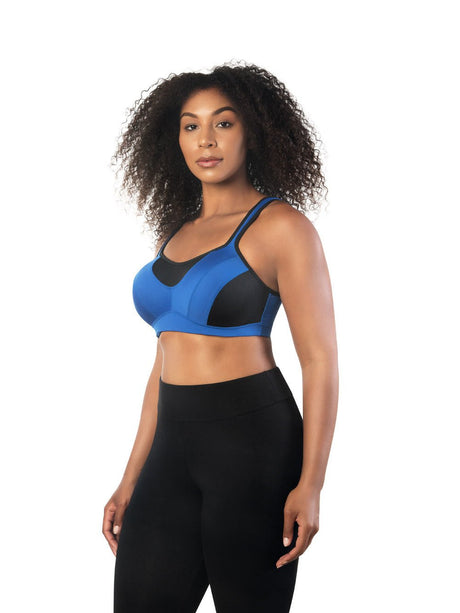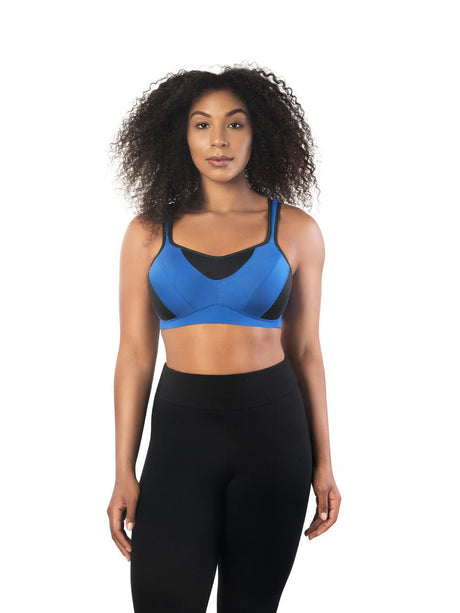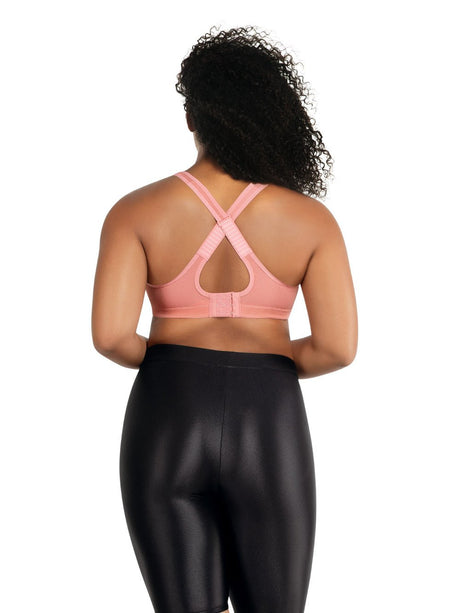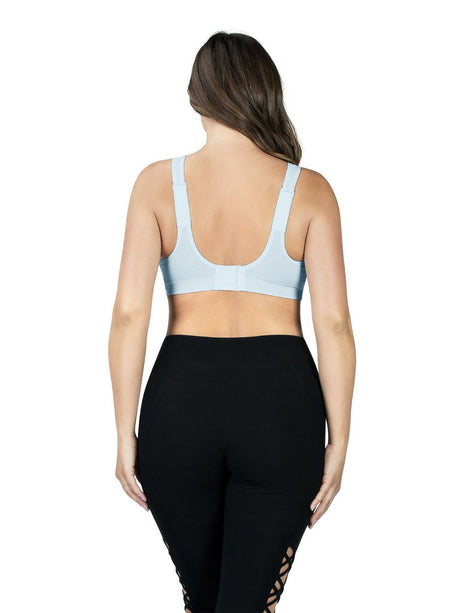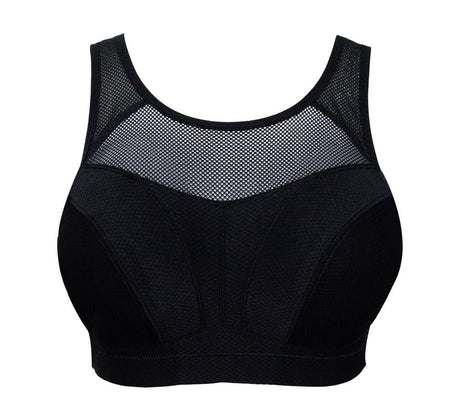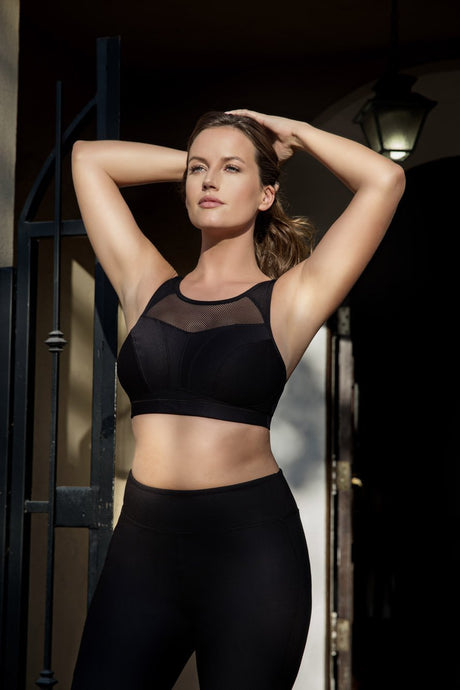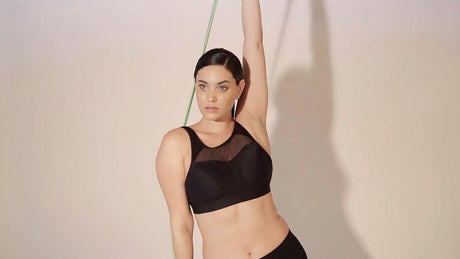
Sexy Sports Bras, Push Up & Padded Sports Bras
(16 productos)- Características
- Más vendidos
- Alfabéticamente, A-Z
- Alfabéticamente, Z-A
- Precio, menor a mayor
- Precio, mayor a menor
- Fecha: antiguo(a) a reciente
- Fecha: reciente a antiguo(a)
FiltrosFiltrar y ordenar
Dominigue Zoe pro Max apoya la ropa interior deportiva 6100
$62.00Precio unitario /AgotadoDisponiblesDominique Soft Support Wireless Full Coverage Sports Bra Plus Size White 6000
$49.00Precio unitario /AgotadoDisponiblesDominigue Max Support Underwire Sports Bra 6100 Plus Size
$62.00Precio unitario /AgotadoDisponiblesParfait Dynamic Padded Performance Sports Bra - Dazzling Blue
$54.00Precio unitario /AgotadoDisponiblesDominigue Sports Bra Underwire Supportive Sports Bra 6100 Plus Size
$62.00Precio unitario /AgotadoDisponibles
When it comes to dragging yourself out of bed for your morning workout, most people need all the motivation they can get. Sometimes it takes three times hitting the snooze button and four cups of coffee until you finally feel semi-ready to take off your slippers and tie up your Nikes. On some days, however, all the sleep and caffeine in the world can’t overcome all of the excuses you create to get yourself out of a workout you don’t want to do. You can always come up with a host of excuses—many of which are even somewhat valid—to avoid exercising. Maybe you’re still getting over the minor cold you had three weeks ago, or perhaps you just don’t have time to blow-dry your hair and make it to the gym. The possibilities are endless, but your sports bra should never make it into your category of e excuses. In fact, quality sports should even act as a motivator, not a deterrent, to get yourself out of bed and get moving.
Wearing the wrong type of sports bra can have a severe negative impact on your motivation to exercise as well as the quality of your workout itself. If you’re serious about your workouts, exercise classes, or the sport you play, you should invest in a quality sports bra that meets all of your needs. Many women who don’t wear the sports bras they should—or don’t wear a sports bra at all—simply don’t know what they’re missing. The world of sports bras is much broader than most people believe. Learning about the many different types of sports bras and their unique design and functionality is an essential step on the path of finding the perfect sports bra for you.
What is a Sports Bra?
A sports bra is any bra that is designed to be worn while you exercise. Exercise can include any type of high-motion activity, such as running, hiking, playing a sport, or strength training. Sports bras are meant to support and secure your breasts through these motion-intensive activities that are more physically rigorous than the rest of your everyday routine.
This classification gets confusing, though, because many women do not only wear a sports bra when they’re heading to the gym for a cardio workout. Sports bras have become common loungewear pieces to wear around the house. Some women even opt to wear a sports bra instead of a regular everyday bra out in public to stay more comfortable. The habit of wearing sports bras outside of the gym has led to many sports
The definition of a sports bra is therefore slightly fuzzy. Any bra marketed for workout or loungewear can technically be classified as a sports bra, but that doesn’t mean that every bra you find in the workout section of your local department store is the right sports bra for you. Not all sexy sports bras are created equal, and the flimsy sports bra you buy to complete your weekend-at-home lounge look should not be the same as the sports bra you pack on a hiking trip.
Sports Bra Versus Normal Bra
A gray area exists between what constitutes a sports bra and a normal bra. Both types of bras are designed to keep your breasts comfortable, supported, and secure. However, they are constructed to fulfill the changing needs of your bust through different activities.
Normal bras are meant to offer comfortable support while you go through your standard daily schedule. These bras feature lightly padded, rounded cups that naturally shape and lift your breasts. They also usually include thin, adjustable straps, hook-and-eye closures, and a hard underwire band for added support. Some everyday bras have a different design— such as strapless, backless, push-up or racerback—to shape your breasts in a certain way or keep your bra invisible underneath specific more revealing articles of clothing.
Most bras, on the other hand, are designed for functionality, not an enhancement. Their purpose is to secure your breasts and minimize motion while you exercise. When wearing a sports bra, most women are more concerned with getting through their workout without discomfort than with how perky their breasts look. Sports bras usually feature thicker straps and bands than regular bras to help reduce bouncing. These bras are also generally designed with stretchier fabric and a more flexible band to allow for more comfortable high-impact movement.
Types of Sports Bras
Sports bras make up an extensive selection of bras. Within the sports bra category, there are many different types of bras. This wide range of sports bra styles is designed to satisfy the varying size, support, and comfort needs and preferences of as many women as possible.
Some sports bras are constructed with extra support and security features to combat the stress of extremely high-impact workouts. Others have more subtle designs that are less restrictive but can accommodate only low- impact activity. Sports bra styles differ in how they look, what level of support they provide, and what range of breast sizes they can accommodate comfortably. There is a different sports bra customized for every breast size, activity, and comfort level, so it’s not too much of a challenge to find a style that meets all of your expectations. To find that ideal sports bra for you, however, you need to know what sports bra styles are out there as well as how to differentiate between them.
High Impact Sports Bras
High impact sports bras are designed to keep your breasts utterly secure through activities that involve a high degree of movement. They are meant to keep your breasts from bouncing while you engage in rigorous exercises like running, dancing, and most other types of intense cardio.
This sports bra style provides maximum support and security, which makes these sports bras prevalent among women with larger busts. However, the protection against bouncing that high impact sports bras offer guards women with breasts of all shapes and sizes from embarrassing and uncomfortable. High impact sports bras are not an ideal choice for women whose sports bras frequently double as loungewear. While high-quality, high impact bras shouldn’t feel uncomfortable or restrictive, their heavy-duty construction of these bras—complete with supportive padded cups and wide shoulder straps—caters to the need for support and security of women who head to the gym or play an intense sport on a regular basis.
Medium-Impact Sports Bras
Medium impact sports bras are—true to their name—designed to be worn while engaging in moderate impact activities. These bras include some additional support features—like light padding, wider straps, and separated cups and underwire in some cases—but not as many as high impact sports bras. Depending on your natural breast size and density, medium impact sports bras can conceivably support you through power walking, slow jogging, or using an elliptical machine.
This in-between sports bra style is a helpful option for women looking for adequate levels of support and security from their bras but wants to avoid the bulky, heavy-duty construction of high impact sports bras that makes some women feel uncomfortable and restricted. However, don’t settle for a medium impact sports bra if the size of your breasts and the nature of your activity warrants a high impact style. It’s better for you, in the long run, to feel slightly more constricted than to suffer the consequences of regularly wearing a sports bra that doesn’t offer the support you need.
Low Impact Sports Bras
Be careful when considering a low impact sports bra. Out of all sports bra styles, low impact sports bras provide the least amount of support and security for your bust. They are single-layer compression bras with narrow straps and include the bare minimum when it comes to supporting features—i.e., no padding, wiring, separated cups, etc.
Low impact sports bras should only be worn for very low impact activities— such as yoga or walking (not hiking)—that does not include any fast or intense movement. These sexy sports bras are also more efficient for women with smaller, lighter breasts and often don’t provide enough security for women with a heavier, full bust to comfortably engage in a sport or workout at any impact level. If you’re looking for a sports bra to wear as every day or loungewear bra—not for working out or playing a sport—low impact sports bras are an ideal option for many women.
Front Closure Sports Bras
As their name suggests, front closure sports bras are sports bras that fasten in front as opposed to those that secure in the back or don’t include any closure at all. The primary purpose of front closure sports bras is to make the process of putting on and taking off your bra before and after your workout more comfortable and convenient. For many women—especially those with larger breasts or curvier figures—putting on and removing their sports bra is the most dreaded part of their workout.
Full-busted women usually require sports bras with a tighter fit and higher level of compression for added support. Unfortunately, these essential support features tend to turn changing in and out of a back closure or no closure sports bra into a frustrating and uncomfortable struggle. Sticky sweaty skin and tight compression material don’t pair well for quick changes. By closing in between your breasts, front closure sports bras allow you to quickly and easily fasten and unfasten your sports bra without a hassle even if you’re still sweaty post-workout. Front closure sports bras are available in high, moderate, and low impact styles.
Plus Size Sports Bras
Shopping for sports bras can be an extremely frustrating and discouraging process for plus size women. It’s hard enough to find a supportive sports bra as a full-busted woman when ninety percent of mainstream sports bras seem to be designed only for cup sizes C and below. When you have large breasts and a full figure, coming across a well-fitting sports bra that secures your breasts without digging into your ribcage can seem next to impossible.
Plus size sports bras for full-busted women with curvy figures include special features like wide straps, padded cups, breathable material, additional adjustable hook-and-eye closures, a seamless design, and more to ensure maximum comfort and support no matter how intense your workout gets. Most high-quality plus size sports bras also have a basic, no-nonsense design that includes only essential features for security and support. Without unnecessary embellishments like straps and cutouts that only serve to make finding a well-fitting bra more complicated, these bras prioritize functionality and comfort above all else.
Padded & Push up Sports Bras
Many sports bras include only a single layer of fabric without any lining or padding on the inside. This flimsy design doesn’t offer enough support and security that’s necessary for larger bust sizes and leaves many women feeling exposed. Padded sports bras are designed with thicker foam-like lining on the inside to provide additional compression that more effectively secures larger breasts as well as creates a balanced, uniform look for your bust.
One of the most common misconceptions about padded sports bras is that they are the same thing as push up sports bras. Push up sports bra are designed with extra padding in the bottom of the cups to make your bust look more full and your cleavage more noticeable. This push-up design doesn’t add much to the functionality of sports bras, but it helps some smaller-breasted women feel more confident in their workout wear. While the extra thick material of padded sports bras can make your breasts appear larger, these bras feature extra lining material to provide extra support and security rather than to enhance your cleavage.
Zip Up Front Sports Bras
Zip up front sports bras serves virtually the same purpose as front closure sports bras. They are designed with a central zipper that acts as the bra’s fastener. However, there is a key distinction between regular front closure sports bras and zip up front sports bras.
The difference is that most standard front closure sports bras feature a hook-and-eye or clip closure. The zippered design of zip up front sports bras provides a tighter fit and additional compression that offers more support and security while still eliminating the hassle and discomfort of changing in and out of alternative sports bra styles. Zip up front sports bras are the ideal choice for fuller-busted women who need a bra with maximum security but also want to bypass the torturous process of peeling a tight sports bra away from sweaty skin.
Compression Sports Bra
The majority of sports bras are compression sports bras. These sports bras don’t include separate cups and are designed with tight-fitting material to compress your bust and keep your breasts secure by holding them snugly against your chest.
Compression sports bras are a better choice for smaller-busted women than for those with large breasts. This style can effectively minimize motion for women with naturally small, perky breasts, but it doesn’t provide adequate support to prevent uncomfortable bouncing for women with a larger, heavier bust.
Encapsulation Sports Bra
Encapsulation sports bras are an alternative to compression sports bras that are designed to better provide the support and security that women with larger breasts need to feel comfortable during their workouts.
Instead of relying on compression to secure your bust, encapsulation sports bras cradle your breasts in individual, separated cups. Most of these sports bras also include additional support features like underwire and padding. Compression sports bras hold breasts down but they don’t prevent large breasts from bouncing in an up and down motion. In addition to being uncomfortable, this motion can eventually lead to lasting chronic pain and permanent sagging. Encapsulations sports bras protect larger, heavier breasts by holding them up in place instead of just pinning them down against your chest.
12 Common Questions About Sports Bras
1. Are sports bras good for your breasts?
In certain situations, sports bras are absolutely good for your breasts. While they’re never a harmful choice, sports bras are not necessarily any more beneficial than normal bras in terms of comfort and support for everyday wear. When it comes to working out or playing a sport, however, sports bras come with special advantages that make them a better choice than a normal bra for these activities.
Sports bras are designed to support your breasts while you’re in motion rather than while you’re going through the sedentary activities of a normal day. As such, they are specially constructed to secure your breasts to keep you comfortable while you exercise as well as prevent soreness, lasting pain, and sagging after your workout is over.
2. Is it bad to not wear a sports bra when exercising?
It’s been established that sports bras provide many benefits to your breasts, but what can happen if you choose not to wear one? The short answer to the question of whether or not it is bad to not wear a sports bra when exercising is, simply, yes. There’s a reason that an entire category of bras exists specifically to be worn while you work out or play a sport. Wearing an everyday bra or no bra at all while engaging in strenuous activity puts you at risk of temporary discomfort that affects your athletic performance, lasting soreness, and even chronic pain.
As a general rule, you should always put on a sports bra every time you plan to do anything that requires significantly more motion than your normal daily activities. When your body moves more, your breasts move, too. The main purpose of sports bras is to hold your breasts against your chest in order secure them and prevent them from bouncing and moving around while you work out or play a sport.
The amount of support you need for your bust while exercising depends on a variety of factors, including the size and weight of your breasts as well as what type of exercise you’re doing. Women with smaller, perkier breasts don’t need as much as those with a fuller bust. For these women, wearing a high-impact sports bra isn’t always a necessity. On the other hand, women with naturally larger, heavier breasts need to wear a sports bra that includes as many extra support features as possible to effectively keep their bust secure and reduce bouncing during exercise.
No matter what bra size you wear, regularly choosing not to wear a sports bra while you work out or practice a sport can have negatively affect your body. The amount of support your sports bra should have to keep your breasts secure depends on the size and weight of your bust, but you should never rely on wearing a standard bra or going braless to exercise. These options do not provide the same level of support for high-intensity activity as a sports bra and don’t offer adequate security even for women with small breasts.
3. Is a sports bra supposed to be really tight?
As a general rule, the fit of your sports bra should feel snug but comfortable. A certain level of tightness is necessary to keep your breasts effectively secured while you exercise. That being said, the fit of your sports bra should never feel restrictive or suffocating. Your sports bra is likely too tight if it creates visible bulges under the band and around the straps while you wear it or leaves red marks or indentations in your skin after you take it off. You should be able to comfortably fit two fingers between your rib cage and the band of your sports bra.
Also, the ideal tightness of a well-fitting sports bra depends on the style of the sports bra. Compression sports bras need to fit more tightly than encapsulation sports bras because they secure your breasts by pressing them down against your chest to prevent them from bouncing while you work out. Encapsulation sports bras, on the other hand, feature separate cups that so it is more important that
4. What do sports bras do for you?
The advantages of sports bras don’t stop at additional comfort and support. Wearing a sports bra style that fits you well and keeps your breasts secure while you work out or play your chosen sport can actually have a notable positive impact on your athletic performance.
When you’re wearing an uncomfortable sports bra that doesn’t fit quite right and doesn’t offer enough support for your bust, it’s only natural that you’ll be more attentive to the discomfort you’re feeling and less focused on your exercise. High-quality sports bras that fit and secure your breasts lets you devote all of your attention to your workout or sport without worrying about whether your breasts are bouncing so much that the treadmill user next to you might notice.
5. Can sports bras increase breast size?
No bra has the power to permanently alter your breast size. While some high-quality bras can lift your breasts or give them the illusion of being larger or smaller than they really are, none of these enhancements are permanent. Many women think that sports bras are incapable of enhancing their cleavage or making their breasts appear larger than they really are like many standard bra styles. It is true that the designs of most sports bras prioritize providing comfort and support over lift and volume, but that doesn’t mean finding a chest-enhancing sports bra is impossible.
If you want your breasts to look larger, stay away from compression sports bras that secure your bust by pressing it down against your chest. Instead, opt for an encapsulation sports bra style that separates your breasts in two individual cups. The rounded shape of these sports bras automatically makes your bust look more full. Also, many encapsulation sports bras include additional enhancement features like extra lining or push-up padding to add even more volume and lift to your breasts. If the thought of heading to the gym in a sports bra that makes your breasts look smaller makes you feel insecure, consider investing in a sports bra that does the opposite and temporarily increases the size and volume of your bust. However, for the long-term health of your breasts, always prioritize support over visual appeal when choosing a sports bra.
Another widespread common misconception about sports bras and breast size is that sports bras can permanently reduce the size of your bust. This theory stems from the tendency of snug compression sports bras to make your breasts look flatter and smaller during wear. However, these effects are no more permanent than the results of a thickly padded bra that adds two cup sizes to your bust while you wear it. Once you remove a compression sports bra after your workout, your breasts will relax away from your chest and the size of your bust will remain the same as it was before you put on the bra in the first place.
6. Do sports bras make your breasts sag?
Sports bras are designed to prevent your breasts from sagging while you exercise. However, don’t be fooled into thinking that wearing any sports bra will help you dodge saggy breasts. In order to reap the perkiness- preserving benefits of sports bras, you must choose a sports bra that provides the right level of support and security for your breasts.
If you have a DD bust and wear a single-layer compression sports bra on a five-mile run, you are putting yourself at risk of sagging. Also, women who choose to wear a low-impact sports bra that provides very little support on a daily basis in lieu of a normal everyday bra might experience more sagging than women who regularly wear underwire bras.
Sports bras themselves don’t make your breasts sag. That being said, wearing an ill-fitting, unsupportive sports bra offers about the same level of protection against sagging as wearing no bra at all. If you’re worried about saggy breasts, make sure that you always wear a sports bra that provides the appropriate amount of support for the size of your bust and the intensity of your exercise. When you’re not sure what level of security you need from your sports bra for any given activity, always go with the most supportive option to be safe.
7. Which sports bras are best for running?
Just as it can lead to chronic pain and joint problems over time, a long-term running habit can also cause lasting pain and damage to your breast tissue if you don’t wear the right type of sports bra. Running is one of the highest impact cardio activities. The repeated, forceful up and down motion of a regular running stride gives your breasts plenty of opportunity for uncomfortable bouncing if you don’t secure them well. When you run, your breasts naturally move up and down and from side to side. This motion can lead to momentary discomfort, long-term chronic pain, and even permanent sagging.
Beyond the intensity of running, another reason why wearing the right type of sports bra while running is that runners generally spend much more time and effort running than they would any other cardio activity. Most women who are serious about running go for a run several times per week. Avid distance runners might rack up five or more miles every day and spend several hours of running every day. Wearing an unsupportive sports bra while you run puts a high level of continuous stress on your breasts for an extended period of time. Accidentally forgetting your high-impact sports bra for your weekly spin class isn’t likely to cause long-term damage to your breasts, but wearing a flimsy sports bra throughout a month of training for a 10k race just might.
If you’re a serious runner, you would probably never dare set out for a run without lacing up your highest-quality, most supportive and comfortable pair of tennis shoes. Don’t hold your sports bra to a lower standard. Put supporting your breasts as high up on your list of priorities as protecting your feet and legs.
The impact level of your sports bra should match the impact level of your workout. Since running is an extremely high-impact, motion-intensive activity, your sports bra should match that same level of intensity. The sports bra you rely on for running should include as many as hfit very snugly to effectively secure your breasts against your chest and restrict motion as completely as possible.
8. What is the best material for a sports bra?
Sports bras are commonly made out of many different materials depending on the style and design of the bra. When it comes to which material is the best one for a sports bra, breathability, support, and comfort are three important factors to consider.
If your sports bra is not made from a breathable fabric, it will quickly become sweaty as you workout. This moisture creates a breeding ground for bacteria, causes you to feel overheated while you exercise, and makes changing in and out of your sweaty sports bra an absolute nightmare. Many high-quality sports bras are made from moisture-wicking material that pulls moisture from your skin and helps it evaporate more quickly to keep your skin cool and dry even when you’re sweating. Sports bras with a high percentage of cotton material also have a high level of breathability.
Support is the main purpose of sports bras, so it is vital that the material of the sports bra you wear contributes to providing enough support for your breasts to keep them secure while you work out. Material that is crafted from a blend of nylon, spandex, and lycra fabrics generally stretches but maintains its elasticity to provide a flexible and snug fit that increases the support of the bra. However, be sure to check that the material also includes a high percentage of cotton to ensure a good amount of breathability.
Breathability and support are major contributors to the comfort of your sports bra. If you are able to find a high-quality sports bra that is comfortable and equipped with a high level of breathability, it will likely be comfortable to wear, too. However, some materials commonly used to make sports bra can cause uncomfortable irritation, especially for women with, particularly sensitive skin. For example, well-known synthetic materials —like nylon, spandex, rayon, and acrylic—often include a range of chemicals that cause itching and other mild allergic reaction symptoms for some women. Even if you don’t normally experience any kind of negative reaction to a certain material, irritation symptoms can come more pronounced in reaction to a sports bra because you sweat more while wearing a sports bra than you do in other everyday clothes.
9. What is a good sports bra for large breasts?
As a general rule, the best sports bra for large breasts is the most supportive sports bra you can find. Because they are heavier than smaller breasts, large breasts require a move supportive sports bra to effectively secure them against your chest and prevent bouncing while you workout.
If you have large breasts, look for an encapsulation sports bra that holds your breasts individually instead of compressing them. Try to find a style that includes as many of the following additional support features as possible: wide padded straps that are adjustable, underwire, sectioned cups, supportive seams, and moisture-wicking fabrics. A bra with these features is the most likely to keep large breasts feeling secure, supported, and comfortable.
10. Is it okay to wear a sports bra to bed?
There are many myths and misconceptions regarding wearing a sports bra to bed. The bottom line is that it is neither good nor bad to wear a sports bra to bed, so it’s definitely okay if that’s the choice you prefer.
Many women think that wearing a sports bra while they sleep will keep their breasts perkier and prevent sagging, but this is not the case. Others believe that going braless while they sleep helps them avoid stunting their breast growth or even developing cancer. None of this is true, either. If you feel more comfortable wearing a sports bra to bed, wear one. If not, don’t; it really is that simple.
11. What is the best sports bra for support and lift?
If you want a sports bra that provides maximum support without flattening your breasts against your chest, a push-up encapsulation sports bra is probably your best option.
This sports bra style features separated, shaped cups with additional padding to make your breasts look larger and perkier. Providing support and lift at the same time, push up encapsulation sports bras offer the best of both worlds for women who want to stay comfortable while they work out without sacrificing the shaped, lifted finish everyday bras offer your bust.
12. How do you know what size sports bra to buy?
Buying the right size sports bra can be difficult, especially when it comes to low impact styles. Many sports bra styles with minimal extra support features come in a size range of XS, S, M, L, XL, etc. These sizes might look simple, but they can be very confusing and misleading if you’re used to buying bras according to cup and band sizes. Fortunately, many sports bra retailers provide useful sizing charts to help you determine which of their sizes matches your measurements.
The sizing of high impact sports bras is usually easier to decipher. Sports bras that include separated cups are generally sized according to standard cup and band bra sizes. Although the bra size to sports bra conversion for these bras is not always exact, your everyday bra size and the high impact sports bra size you need should match up pretty well.

SAVE 15%!
Join us for exclusive offers and a 15% discount on your first order!








